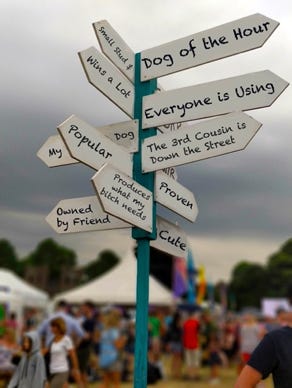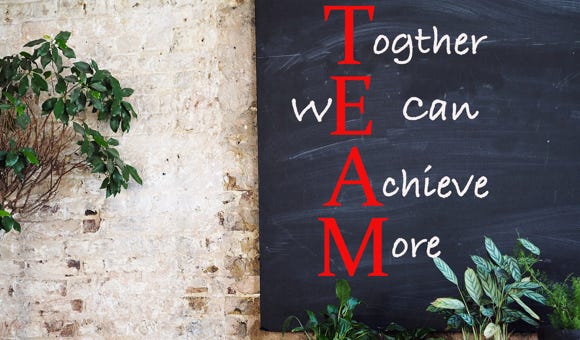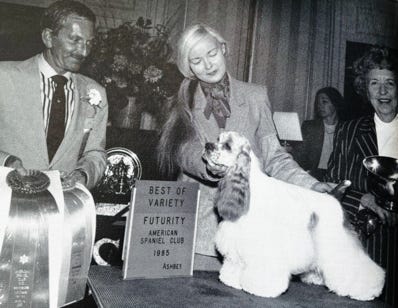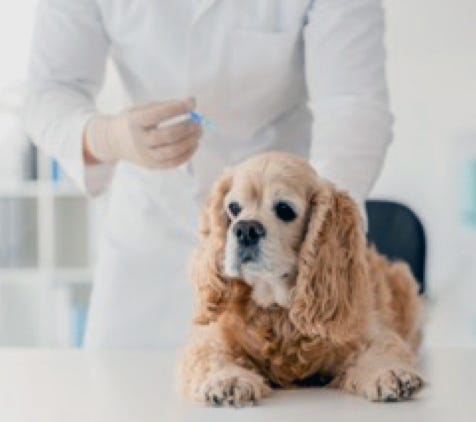Greater Denver Area Cocker Spaniel Club
it’s Show Time!
Helping Breeders & Exhibitors Succeed



How Well
Do You Know The Breed?
by
Deborah McKenna
Nearly forty years ago, I learned a valuable lesson from an older, respected, and successful breeder. At that time, the cocker world was shiny, new, and very exciting to me. It was a lesson that I have never forgotten. It was a powerful piece of wisdom and insight that aided and helped shape my thinking and pushed me to improve my knowledge of the breed. I still use this lesson today when evaluating my dogs and the dogs I show for others.
I was in my early twenties then, a first-time cocker owner and a new member of a large local cocker club in another state. Like many of us, I struggled to understand the terminology used in the breed standard, learn to groom, trim, train, and show my dog. Like many newcomers, I was overconfident in my newfound knowledge. One day, this kind, respected, and long time breeder took me aside and said,
“You don’t really know the breed unless you can find at least ten faults on your dog.”
This doesn’t just mean glaring faults like a sway back or a bad bite. But everything in between, down to the minor fine points that you would improve, such as the tooth size or lack of horny pads on your dog.
It took many years of attending our breed’s National Specialty shows and watching how the top winners moved, were trimmed, and trained. It took many years of sitting ringside, watching the top Sporting, Working, and Herding dog’s movement. It took time and effort to read articles on how structure affects movement. It took time to understand the balance between breed type and sporting movement.
Can you find at least ten faults or areas that need improvement in your dogs? Ask yourself, “How well do I know the breed standard?”
I recently asked several older experience successful breeders, “ What is the best advice you have ever received that impacted your breeding program? Share it with us!” The following are their responses.
From Marcia Joslyn of Gazon Cockers: “Anne Rogers Clark once told me, ‘When choosing puppies in a litter, keep the cute bitch to show, and also her well built sister for breeding.’ Often your best brood bitches are the more common ones. Held true for me. If you can only keep a few dogs. Keep your best bitches. You can breed to any dog/bloodlines in the world. If you want to keep a male in a litter he should be specials quality for your enjoyment or important for your breeding program. Such as old healthy bloodlines or you and have others who want his pedigree. When breeding a litter with your foundation bitch. Use your pedigree and honest critic of your bitch. When breeding to an outcross, breed her to a proven producer of a trait you know your bitch and her lines need. Do the same with line-breeding. Choose the stud dog who is dominant for the good of your lines." Marcia was a very successful breeder and exhibitor who gained an excellent reputation of breeding a line of cockers known for their soundness, movement, and showmanship. Marcia lives in Minnesota and bred over 150 champions from 1981-2016. Marcia’s keen interest in anatomy and movement developed from her degree in Occupational Therapy and her 10 years experience as a girls gymnastics judge. As a new breeder, this lead her to “read everything she could get her hands on” including Al Grossman’s, “Breeding Better Cocker Spaniels” which became her bible! In January of 1979, Al gave her an important piece of advice, “Buy the best bitch you can get your hands on, regardless of color.” Marcia also incorporated Al’s advice to “breed to the best line-bred dog with a line of documented traits and health testing.“ The rest is history!

“There is no more important ingredient in creating a
breeding program than the bitch. They are solid gold and without-a-doubt the keystone upon which the entire
structure of what you will build must rest upon.”
By Richard Beauchamp
Invest in Gold!
Are You A Breeder Or Do You Just Breed Dogs?
by Ms. Dany Canino
Anyone can breed dogs, but it takes someone very special to wear the badge of a breeder. Every year thousands of dogs end up in animal shelters all over the country. Where did these dogs come from? Can we honestly put the entire blame on the puppy mills or the casual backyard breeder? Or, could it possibly be that many of these unfortunate dogs are the result of progeny produced by "professional breeders?”

Let Your Dog Shine in the Show Ring by Richard Beauchamp
“All dogs have faults. The great ones just carry them well.” My mentor gave me this piece of advice early on… I have never forgotten it, and time and experience themselves have proven that truer words have probably never been spoken. Something else I’ve learned over the years that I would add is that the talented exhibitor becomes expert by never allowing those faults or failings to be seen or, if seen at all, obscured by the dog’s quality… I am talking about presenting a dog so well that the dog’s qualities stand out.

What is a Stud Dog? by Richard Beauchamp
Few, if any, outside breeders would jeopardize his own carefully laid foundation by breeding to a dog that has few or no producing credentials. The clever breeder is just as selective in stud dogs as he should have been in assembling the best bitch line possible.
This is where our writer should actually begin his breeding program - by purchasing the best possible bitch he can that comes from a line of quality producing bitches. And then his next project is to find, regardless of where in the world the dog resides, the right stud dog for her. I italicize the word stud dog because so few people really know the true meaning of the word.

Did you ever wonder why people disagree about the winners at a dog show? We all have at one time or another, but we know from our experiences that what we think we observed usually depends on many things. At most shows it’s a matter of where you sit or stand during the judging and what you know about the breed standard, structure and movement...

If there is a universal fault apparent in the North American show dog it is, without a doubt, in the front end of the caboose. It is interesting, however, that when there's talk about building good fronts on our dogs the conversation is most often inclined to confine itself to layback or angulation of the shoulder. Correct respective shoulder angulation is certainly not easy to achieve, but the shoulder is not alone when it comes to achieving correct front construction. Not enough consideration is given to the return and lay of another very important bone in the front assembly--the upper arm.
The All Important
(and Neglected) Upper Arm
by Richard Beauchamp

“Show Quality” vs “Finishable”
At a recent dog show, several littermates of both sexes, handled by assorted novice owners, were entered in the 9-12 Month Puppy class. While none of the puppies exhibited disqualifying faults, they were generic in type and not what I would consider “show quality.” The judge that day agreed. The puppies were not up to the competition, and the owners were disappointed that a younger, better-made puppy from the 6-9 Month class beat them for Reserve. At the completion of breed judging, one of the novice owners, who had seen me at earlier shows, approached me and asked, “What happened?”

Structure & Locomotion by Ann Seranne
Like love and marriage, structure and locomotion "go together" and cannot be divorced from each other. A study of both is essential for every dog breeder and for every judge. Just as the artist or sculptor needs knowledge of anatomy in order to sketch or sculpt the human body, so must the breeder or judge know what lies beneath the skin and coat to be able to evaluate the true quality of a dog. When a dog is correctly built, its movement will be smooth, graceful and efficient. A good shoulder, together with an upper arm correctly positioned…


Five Concepts Toward Successful Breeding by E.K. Mincey, Ph.D.
In order to establish some common ground for discussion it is necessary to define what one means by a successful breeding program. What follows are five concepts which I feel are the most important for new individuals who are interested in success in the dog breeding world, i.e, top winning show dogs.
An excellent article for breeders wanting to improve as well as new

The Importance of the Local Club
Many breeders and exhibitors need to recognize the value of their help, wisdom, and experiences for those to whom the cocker world is shiny and new. Individual club members must see the importance of working together as a team, supporting, encouraging, and educating those new to the sport of pure-bred dogs.
The Beginning: An Eye For A Dog by Kristi Tukua
An eye for quality in a chosen breed can be refined and improved through education by mentors, attending seminars, watching dogs in the ring, and practice evaluating puppies. Most Cocker fanciers probably got their first Cocker as a child, perhaps during the breed’s high-popularity years. Cockers were a frequent feature on calendars and other print ads. Many eyes are drawn to the long ears and soft look of the Cocker face!

A Brave New World Of Canine Genetics by Diane Klumb
I have spent the last year doing the pedigree research in a single breed for an autosomal recessive disease as part of an AKC Canine Health Foundation study, the ultimate goal of which is to isolate the gene for hereditary cataracts, This involves locating dogs from three groups- Normals (dogs not carrying the gene at all), Carriers (dogs carrying a single copy of the gene, phenotypically normal, but passing the gene to half their offspring) and Affected (these dogs have received two copies of the recessive gene, and are very likely to develop the disease, although, for unknown reasons, they may not).

Starting Over: When You Must Back Up to Get Ahead
One of the hardest lessons to learn and to accept in our sport is that it will sometimes be necessary to rethink our decisions. However costly those decisions might have been, it usually proves even more costly to ignore the warning signs and forge ahead. When we are working with genes, Mother Nature often gets the last laugh. Also, because there is much subjectivity in the sport, we will regularly encounter negative individuals who do not play well with others. That may require us to reconsider our strategy if we want to continue on a positive path.


AKC Breeder Spotlight: Lisa Gaertner of Pinecliff Cocker Spaniels
Lisa Gaertner of Pinecliff Cockers is a lifelong New Jersey resident and has owned Cocker Spaniels for the past 30 years. She is an AKC Breeder of Merit, member of the American Spaniel Club, treasurer of the Keystone Cocker Spaniel Club, and board member of the Cocker Spaniel Club of New Jersey. In addition to putting together four Specialty Shows a year with her clubs, Lisa is part of a group that was instrumental in reinstituting the Cocker Spaniel cataract research programs.
How Do I Get Started in Dog Shows?
Participating in dog shows can be beyond daunting for newcomers. It’s tough to be the new kid on the block, especially when it appears everyone else has been taught a secret set of dance steps while you bumble along, oblivious to the judge’s instructions or the rules of competition. The good news is that feeling will soon pass. After all, everyone is a beginner at the start. Following the tips below, you’ll soon find your bearings and get caught up in the contagious camaraderie that defines the very best of the dog show world.


Junior Showmanship
Participating in Junior Showmanship will teach your child many important life lessons — how to be a good sport, how to put one’s mind to something and master it; and how training can lead to a very special bond with a dog.
AKC Code of Sportsmanship
(Some things we should never forget!)
The sport of purebred dog competitive events dates prior to 1884, the year of AKC’s birth. Shared values of those involved in the sport include principles of sportsman- ship. They are practiced in all sectors of our sport: conformation, performance and companion.
